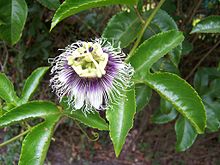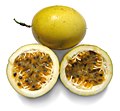Passiflora edulis
| Passiflora edulis | ||||||||||||
|---|---|---|---|---|---|---|---|---|---|---|---|---|

Fruits of Passiflora edulis , |
||||||||||||
| Systematics | ||||||||||||
|
||||||||||||
| Scientific name | ||||||||||||
| Passiflora edulis | ||||||||||||
| Sims |
Passiflora edulis is a species from the passion flower family (Passifloraceae) belonging to the genus of passion flowers ( Passiflora ). The epithet edulis means "edible". Within the species, different varieties and forms are distinguished, among which forma edulis (purplegranadilla)and forma flavicarpa (yellow granadilla) have the greatest economic importance. Fruits of both forms are also on the market in Central Europe, where they are usually referred to as passion fruit or maracuja (spelling also marakuja or maracujá ).
Distribution and cultivation
Passiflora edulis is native to Brazil , Paraguay and northern Argentina . Because of its fruits it is now cultivated worldwide in the tropics and subtropics. It has the greatest commercial importance among the edible passion flower species. Forma edulis is more tolerant of cold than f. flavicarpa and is therefore more likely to be grown than the latter at higher altitudes (1000 to 2300 m). F. flavicarpa is, unlike f. edulis , resistant to infestation by Fusarium and soil-living nematodes and is therefore sometimes used in plantations as a base for f. edulis used. Crosses of the two forms are also grown, and there are other varieties.
description
Passiflora edulis is a woody climber whose shoots can be up to ten meters long. It can be anchored to suitable supports with tendrils . The dark green, finely serrated leaves, glossy on top, are alternate , three-lobed (in young plants also unlapped) and reach 5 to 25 cm in length and width.
The diameter of the flower (with five stamens ) is between six and eight centimeters. The inflorescence is made up of five sepals (white on top, greenish underneath) and five white petals . The four- to five-row, wavy corona is purple at the base ( darker in f. Flavicarpa than in f. Edulis ), otherwise white. The f. edulis - as opposed to on -pollination instructed f. flavicarpa - self-fertile .
The fruit is a berry . The skin of the hen's egg-sized, spherical to oval fruits of the f. edulis brown-violet and becomes wrinkled when ripe. At f. flavicarpa , the oval to egg-shaped fruits are significantly larger (usually between eight and twelve centimeters long) and when ripe they are yellow and smooth-skinned. Inside find numerous seeds (at f. Edulis black, at f. Flavicarpa brown), by a juicy-jelly-like, yellow-orange, respectively Arillus (also referred to as pulp) are surrounded.
Use and ingredients
The edible fruits of Passiflora edulis are used for raw consumption and for juice production and are also exported to Europe. The fruits of f. flavicarpa are a little less aromatic than those of f. edulis and, because of its higher acidity, better suited for juice production. The fruits of f. edulis , on the other hand, are the passion fruits most frequently offered in Central European supermarkets. Use finds the fruit in different ice or dessert preparations such as Pavlova .
Passion fruit juice contains sugar ( sucrose , glucose , fructose ) and organic acids (predominantly citric acid and malic acid ). The vitamin C content is on average around 30 to 50 mg / 100 ml; Furthermore, niacin (outdated designation: vitamin B 3 ) and riboflavin (vitamin B 2 ) are present in significant quantities. Beta-carotene dominates among the carotenoids present . For the aromatic flavor is in particular a number of volatile esters responsible (u. A. Butyrate , Buttersäurehex-3-enyl ester , ethyl acetate , ethyl butanoate , hexyl butanoate , the corresponding ester hexyl or ethylhexanoate ).
An oil ( passion fruit oil ) is obtained from the seeds of Passiflora edulis , which is used in cosmetic products (sun protection, massage oils). The main ingredients are linoleic acid , oleic acid and palmitic acid .
In addition to other Passiflora, the leaves of Passiflora edulis are also used in South America as a diuretic, for inflammation or as a sedative for asthma . Flavonoids contained in passion flower preparations for calming purposes or as a sleep-promoting agent have also been detected in the leaves of Passiflora edulis (common preparations available, however, are based on Passiflora incarnata ).
literature
- Wolfgang Franke : Crop science, usable plants of the temperate latitudes, subtropics and tropics. 3rd edition, Thieme, Stuttgart / New York, NY 1985, ISBN 3-13-530403-5 .
- Karl Herrmann: Exotic Food. 2nd edition, Springer, Berlin a. a. 1987, ISBN 3-540-16830-3 .
- Bettina Ulmer, Torsten Ulmer: Passion flowers. Self-published, Witten 1997, ISBN 3-00-000684-2 .
Web links
- Entry at GRIN (Engl.)
- Julia F. Morton: Passionfruit , in Fruits of warm climates , pp. 320-328
- Cassia Roberta Malacrida, Neuza Jorge: Yellow passion fruit seed oil (Passiflora edulis f. Flavicarpa): physical and chemical characteristics . Braz. arch. biol. technol. Vol. 55, No. 1 Curitiba, 2012
Individual evidence
- ↑ George A. Burdock: Fenaroli's Handbook of Flavor Ingredients . CRC Press, 2004, ISBN 978-1-4200-3787-6 , pp. 145 ( limited preview in Google Book search).
- ↑ M. Winter, R. Klöti: About the aroma of the yellow passion fruit. (Passiflora edulis f. Flavicarpa) . In: Helvetica Chimica Acta , Volume 55, Issue 6, pp. 1916–1921, July 10, 1972 ( doi : 10.1002 / hlca.19720550609 ).




